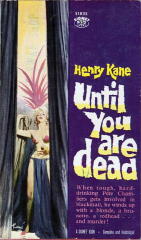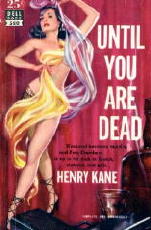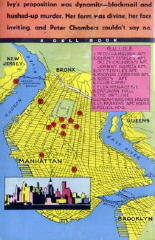Mon 7 Jul 2008
Review: HENRY KANE – Until You Are Dead.
Posted by Steve under Authors , Characters , Reviews1 Comment
HENRY KANE – Until You Are Dead.
Signet S1835; paperback reprint, August 1960 (Barye Phillips cover). Hardcover edition: Simon & Schuster, 1951. UK editions: T. V. Boardman, hc, 1952; ppbk, 1953. Earlier US paperback edition: Dell 580, 1952, mapback (Victor Kalin cover).

In order of publication, Until You Are Dead was either the sixth or seventh of Henry Kane’s series of detective tales featuring a suave Manhattan private eye named Peter Chambers. (The reason I’m not more definitive on this is that there were two of Chambers’ adventures in 1951. With nothing else to go on, I’m going to suggest that this one is #6, since it was came out from Simon & Schuster, who published the first five, and A Corpse for Christmas appeared from Lippincott, suggesting a change in publisher. The Christmas aspect of the latter also suggests that it was published later in the year, once again making Until You Are Dead the earlier one.)
Such is life in the fast armchair-detective lane.
Also of note is that Kane’s first three short stores, one of which, “Kudos for the Kid” (May 1947) may have been the overall first appearance of Peter Chambers, were published in Esquire, which was a prestigious magazine to be in at the time.
After 1951, though, all of Kane’s novel length fiction in the US, most but not all adventures of Peter Chambers, came out as paperback originals, first from Avon, then Dell and many of the others including Signet, before both Kane and Chambers ended up in a series of X-rated books from Lancer in 1970.

Oops. I see I erred in one thing I just said. There was a series of novels about Inspector MacGregor that appeared in hardcover from Macmillan between 1965 and 1968. These all took place in New York City, but I don’t know if I’ve ever seen any of them. (I no longer remember all of the books I’ve seen.)
It’s not clear how sharp an operator Chambers is, and how close to the legal edges he usually runs, but he seems to know his way around and to know a lot of people who come close to running the town. Really running the town, that is. But either way, he draws the line at aiding and abetting a jazz musician turned blackmailer — the guy had seen a killing in a night spot men’s room, a guy high in the rackets who tossed Kermit Teshle (that’s his name) a hundred dollar bill and left.
Teshle wants more. Chambers says no. Enter Ivy Teshle, his sister, a girl who dances for a living while trying to make it to Broadway. (See either of the two covers shown.) She meets him in his office, worried about her brother, on page 15, and on page 17 she is kissing him. Chambers says yes.
It is that kind of book, and Chambers is that kind of private eye, and Henry Kane is that kind of writer.
Kermit ends up dead, and Chambers is in it up to his neck.

As a writing stylist, Henry Kane is pretty good. Not in Raymond Chandler’s league, but he can rattle off the dialogue when he wants to, which is often, and he can go into philosophical matters with equal ease. Once in a while these discussions become what in the vernacular might be called full-fledged rants, or here in New England, “wig-outs.” Example, pages 85 and 86:
Me. I like to drink (among other things). So what?
Whew. He caught me there, but only twice, thank goodness. (How about you?)
With a passage like that to recommend this book, I wish the mystery had an ending to match. It’s OK, don’t get me wrong. It just isn’t up to the one I’d been waiting for. (I don’t think it could have.)
September 10th, 2010 at 8:11 pm
[…] and his series character Peter Chambers, read Steve Lewis’s review of Until You Are Dead, here earlier on this blog. […]